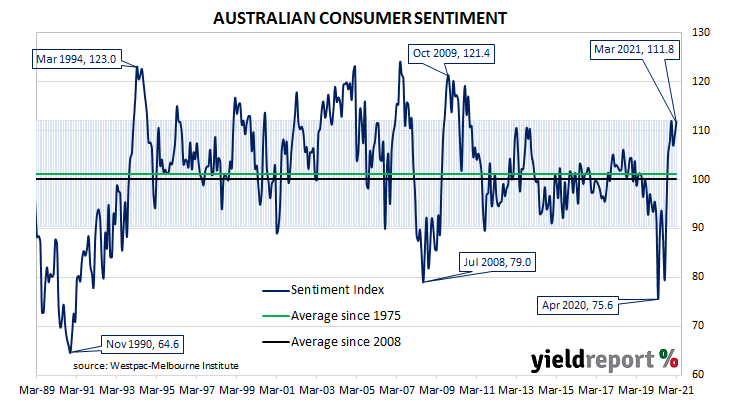Summary: Household sentiment improves again in March; improving economic conditions and prospects, domestically and abroad; all five sub-indices higher; unemployment index lower; sentiment index well above long-term average.
After a lengthy divergence between measures of consumer sentiment and business confidence in Australia which began in 2014, confidence readings of the two sectors converged again around July 2018. Both readings then deteriorated gradually in trend terms, with consumer confidence leading the way. Household sentiment fell off a cliff in April but, after a few months of to-ing and fro-ing, it then staged a full recovery.
According to the latest Westpac-Melbourne Institute survey conducted in the first week of March, household sentiment has improved again, taking it to an almost-elevated level. The Consumer Sentiment Index rose from February’s reading of 109.1 to 111.8.
“The main factors driving the Index are improving economic conditions and prospects, both domestically and abroad, particularly as they relate to our labour market,” said Westpac chief economist Bill Evans.

Treasury bond yields fell along the curve following noticeable falls in US Treasury bond yields overnight and comments by RBA chief Phillip Lowe during a speech in Sydney. By the close of business, the 3-year ACGB yield had lost 3bps to 0.24%, the 10-year yield had shed 6bps to 1.71% while the 20-year yield finished 10bps lower at 2.35%.
In the cash futures market, expectations of a change in the actual cash rate, currently at 0.03%, fell back slightly. At the end of the day, contract prices implied the cash rate would rise slowly to around 0.10% by mid-2022.
All five sub-indices registered higher readings, led by an improvement in the “Economy, next 12 months” sub-index.
The Unemployment Expectations index, formerly a useful guide to RBA rate changes, fell from 114.5 to 112. Lower readings result from fewer respondents expecting higher unemployment in the year ahead.

